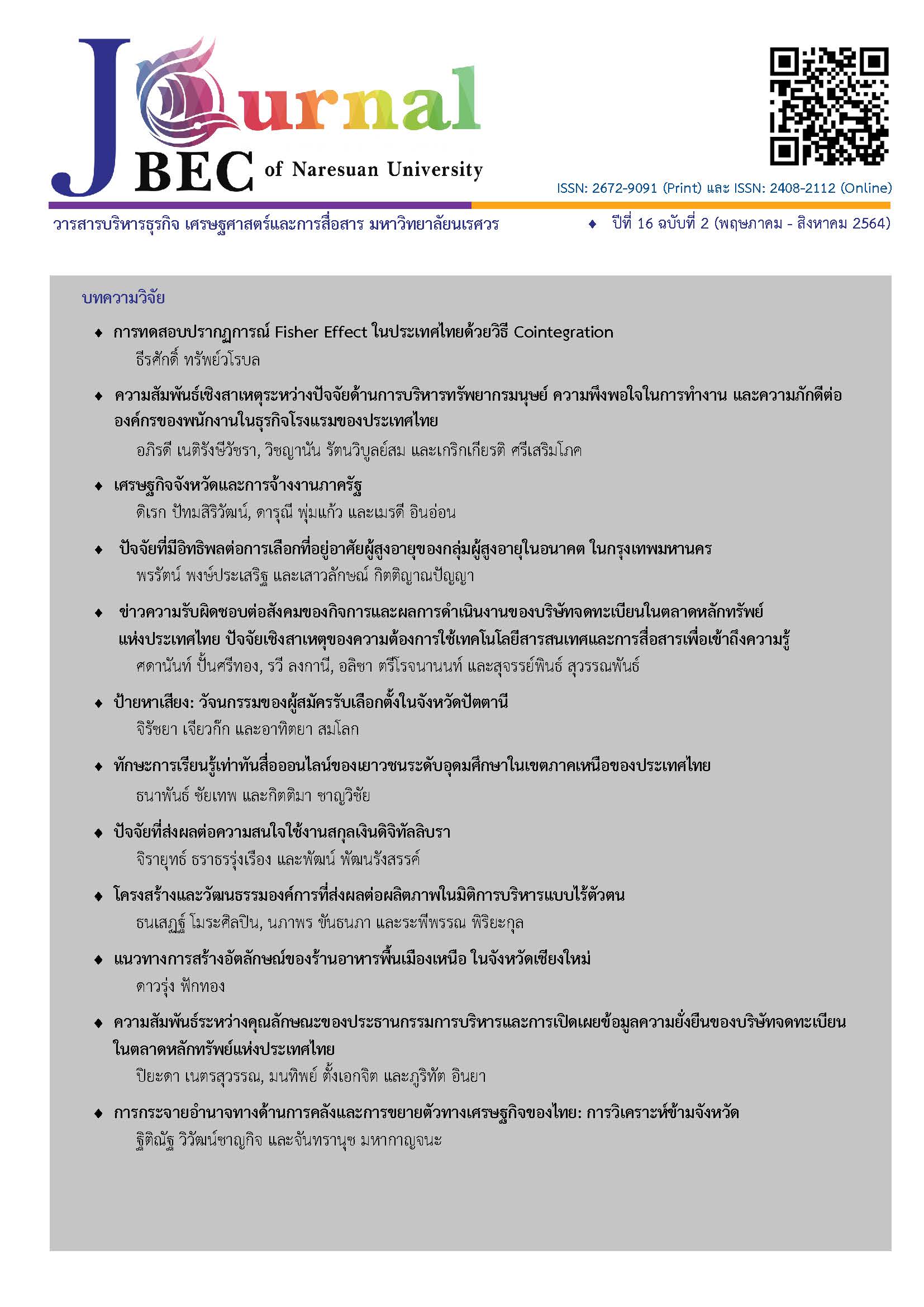ข่าวความรับผิดชอบต่อสังคมของกิจการและผลการดำเนินงานของบริษัทจดทะเบียน ในตลาดหลักทรัพย์แห่งประเทศไทย
Main Article Content
บทคัดย่อ
ข่าวกิจกรรมตามความรับผิดชอบต่อสังคมที่เผยแพร่ในหนังสือพิมพ์เป็นข้อมูลสำคัญที่ทำให้เกิดการรับรู้การดำเนินงานตามความรับผิดชอบของกิจการและเป็นข้อมูลสะท้อนว่ากิจการได้ดำเนินการตามความรับผิดชอบต่อสังคมในรูปแบบใด งานวิจัยนี้ได้ศึกษาการดำเนินงานตามความรับผิดชอบของสังคมที่ปรากฏในข่าวของหนังสือพิมพ์รายวันโดยศึกษาอิทธิพลของข่าวกิจกรรมที่บริษัทดำเนินงานตามความรับผิดชอบต่อสังคมที่มีต่อผลการดำเนินงานของธุรกิจซึ่งผลการวิจัยที่ผ่านมายังไม่ได้ข้อสรุปที่ชัดเจน วัตถุประสงค์ของการศึกษานี้ คือการศึกษาอิทธิพลของข่าวการดำเนินกิจกรรมเพื่อความรับผิดชอบต่อสังคมต่อผลการดำเนินงานของธุรกิจ และการวิเคราะห์อิทธิพลของข่าวความรับผิดชอบต่อสังคมแต่ละประเภทที่มีต่อผลการดำเนินงาน นอกจากนี้ยังได้วิเคราะห์ต่อไปถึงอิทธิพลของความถี่และความครอบคลุมของข่าวการดำเนินความรับผิดชอบต่อสังคมที่มีต่อผลการดำเนินงาน ผลการศึกษาพบว่า ข่าวความรับผิดชอบต่อสังคมด้านสิ่งแวดล้อมมีอิทธิพลในทางบวกต่อผลการดำเนินงานที่วัดในทางการเงิน แสดงให้เห็นว่าธุรกิจที่ให้ความสำคัญต่อสิ่งแวดล้อมและเผยแพร่ข่าวสิ่งแวดล้อมทำให้ธุรกิจมีผลการดำเนินงานที่วัดด้วยข้อมูลทางการเงิน ได้แก่ อัตรากำไรต่อสินทรัพย์รวมและกำไรต่อหุ้นที่ดีด้วย ผลการวิจัยจึงสนับสนุนทฤษฎีของผู้มีส่วนได้ส่วนเสียที่อธิบายว่าการให้ความสำคัญต่อผู้มีส่วนได้ส่วนเสียนอกจากกลุ่มผู้ถือหุ้นมีผลทำให้ผลดำเนินงานของกิจการของกิจการดีขึ้น
Article Details
เอกสารอ้างอิง
Borghesi, R., Houston, J.F., & Naranjo, A. (2014). Corporate Social Responsibility Investment: CEO altruism, reputation, and shareholders interest. Journal of Corporate Finance, 26, 164- 181.
Chinprateep, A. (2015). Corporate Social Responsibility and the Return on Assets. Local Administration Journal, 9(1), 118-132.
Da, Z., Gao, P., & Engelberg, J. (2011). In search of attention. Journal of Finance, 66(5), 1461–1499.
DeAngelo, H., DeAngelo, L., & Stulz, R. (2006). Dividend policy and the earned/ contributedCapital mix: a test of the life-cycle theory. Journal of Financial Economics, 81, 227-254.
Dhurakij Pundit University Research Center. (2005). Survey on Consumer’s Behavior and Attitude toward Corporate Social Responsibility of the Business organization in Thailand. Retrieved October 13, 2017, from https://www.dpu.ac.th/dpurdi/upload/ public/raeczmrtt1wo4wg4oc.pdf.
Elkington, J. (1997). Cannibals with forks –Triple bottom line of 21st century business. Stoney Creek. CT: New Society Publishers.
Flammer, C. (2012). Corporate Social Responsibility and Stock Prices: The Environment Awareness of Shareholders, MIT Sloan School of Management.
Freeman, R. E. (2001). A stakeholder theory of the modern corporation. Perspectives in Business Ethics Sie, 3(144). 38-48.
Jaggi, B., & Freeman, M. (1992). An examination of the impact of pollution performance on economic and market performance: Pulp and paper firms. Journal of Business Finance and Accounting, 19(5). 697-713.
Jensen, M. & Meckling, W. (1976). Theory of the firm: Managerial behavior, agency costs and ownership structure. Journal of Financial Economics, 3(4), 305-360.
Kanter, R.M. (1999). From spare change to real change: the social factor as beta site for business innovation. Harvard Business Review, 77(3), 122-132.
Khunpolkaew, C. (2007). Value Building thru CSR Process (CSR in Process, in Thai). Productivity World, 12(71), 82- 85.
Knox, S., & Maklan, S. (2004). Corporate social responsibility: moving beyond investment towards measured outcomes. European Management Journal, 22 (5), 508-515.
Kornthongtawelarp, T. (2010). The relationship corporate social responsibility and financial performance indicated by return on asset (ROA) and return on equity (ROE) case study : Companies Listed in the Stock Exchange of Thailand (Doctoral dissertation, Thammasat University,Bangkok). Retrieved October 13, 2017, from http://digi.library.tu.ac.th/thesis/ac/0584/01title- illustration.pdf.
Kotler, P., & Lee, N. (2005). Corporate Social Responsibility: Doing the most good for your company and your cause. Hoboken: NJ. Wiley.
Laosirihongthong, T., Tungkaprasert, P., Sakolbancherd, W. & Sangwongrassame, P. (2009). Corporate Social Responsibility and Supply Chain Management Part 2. TPA News, 2009(143), 64-66.
Laszlo, C. (2003). The sustainable company: How to create lasting value through social and environmental performance. Washington, DC: Island Press.
Low, C., & Cowton, C. (2004). Beyond stakeholder engagement: the challenges of stakeholder participation in corporate governance. International journal of business governance and ethics, 1(1), 45-55.
Margolis, J.D., and Walsh, J.P. (2003). Misery loves companies: rethinking social initiatives by business. Administrative Sciences Quarterly, 48(2), 268-305.
McCombs, M. E., & Shaw, D. L. (1972). The Agenda-Setting Function of Mass Media. The public Opinion Quarterly, 36(2). 176-187.
Pipitsombut, S. (2007). Content analysis of news coverage for public relations purposes in Thai daily newspapers. Master thesis, M.A., Chulalongkorn University, Bangkok.
Pipitsombut, S. & Benjarongkij, Y. (2008). Content analysis of news coverage for public relations purposes in Thai daily newspapers. Journal of Public Relations and Advertising, 1(2), 18-31.
Porter, M.E., & Kramer, M.R. (2002). The competitive advantage of corporate philanthropy. Harvard Business Review, 80(12), 56–68.
Porter, M., & Vanderlinde, C. (1995). Toward a new conception of the environment competitiveness relationship. Journal of Economic Perspectives. 9(4), 97- 118. Retrieved April 9, 2017, from www.jstor.org/stable/2138392
Rukphanichmanee, S., Duangchaiyusuk, S. & Thammasiri, W. (lecturer). (2018). Corporate Social Responsibility Information Disclosures and Organizational Performance of Listed Companies in the Stock Exchange of Thailand. In The Second UTCC Academic Day 2018 (pp.602-615). Bangkok: The University of the Thai Chamber of Commerce.
Sereerat, S. (1996). Marketing Research. Bangkok: Dharmasarn Printing Company Limited.
Stäbler, S. (2016). Impact of Corporate Social Responsibility News on Customer Brand Perception and Stock Return performance (Research report). University of Cologne, Germany.
Sthapitanonda, P. & Nueangjamnong, P. (2016). Corporate Social Responsibility Communication: From concept to action and future research challenges. Journal of Public Relations and Advertising, 9(1), 73-92.
Sustainable Business Development Institute. (n.d.). CSR for Corporate Sustainability. RetrievedNovember 17, 2017, from http:://www.set.or.th/yfs/main/download/YFS2018_ExamReading01.pdf
Tetlock, P.C. (2007). Giving content to investor sentiment: The role of media in the stock market. Journal of Finance, 62(3), 1139- 1168.
The Saylor Foundation. (n.d.). Stakeholders and Corporate Social Responsibility. Retrieved January 30, 2017, from https://www.saylor.org/site/wpcontent/uploads/2013/09/Saylor. orgs-Stakeholders- and-CSR.pdf.
Tongkachok, T. (2013). The Causal Model of Transformational Leadership, Corporate Governance, Stakeholder Engagement and Corporate Social Responsibility in the Listed Companies: A Review. Executive Journal, 33(2), 80-88.
Wigley, S. (2008). Gauging consumers’ responses to CSR activities: Does increased awareness make cents?. Public Relations Review, 34(2008), 306-308.


